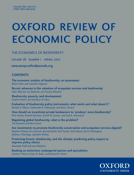
The economic analysis of biodiversity: an assessment
with Helm, Oxford Review of Economic Policy, 28:1, 1-21, 2012.
Biodiversity is complex, difficult to define, difficult to measure, and often involves international and intergenerational considerations. Biodiversity loss presents significant economic challenges. A great deal of economics is required to understand the issues, but a simple and important observation is that most species and ecosystems are not traded in markets, so prices are often absent and biodiversity is under-provided. Despite the formidable obstacles to high-quality economic analysis, economics has plenty to offer to biodiversity policy. First, economic valuation techniques can be employed to roughly estimate the value of the benefits provided by biodiversity and ecosystems. Second, assessing the ‘optimum’ amount of biodiversity involves recognizing that the conversion of natural capital into manufactured and human capital has so far generated vast amounts of wealth. While there may have been ‘too much biodiversity’ in the past, economic analysis suggests that this is a difficult position to hold now. Third, econometric techniques and carefully designed policy studies can assist in determining what policies are most suited to different contexts to cost-effectively reduce biodiversity loss. Fourth, political economy is helpful because international coordination is often required—ecosystems do not respect national borders and many biodiverse ecosystems are in poorer countries. This paper synthesizes the issues and proposes a research agenda, which includes improving the measurement and accounting of natural capital, improving valuation techniques and theory to provide greater guidance as to the ‘optimum’ biodiversity, and developing our understanding of the merits of different alternatives for government intervention to reduce biodiversity loss.